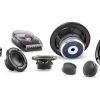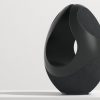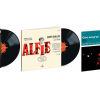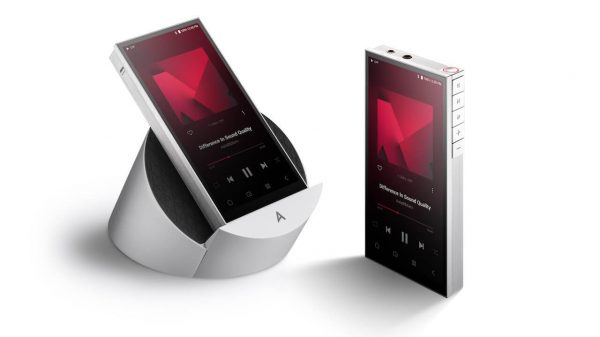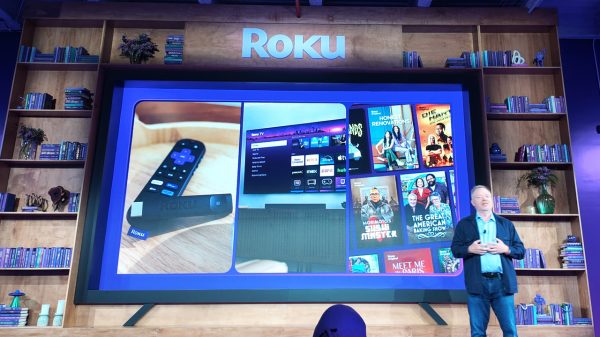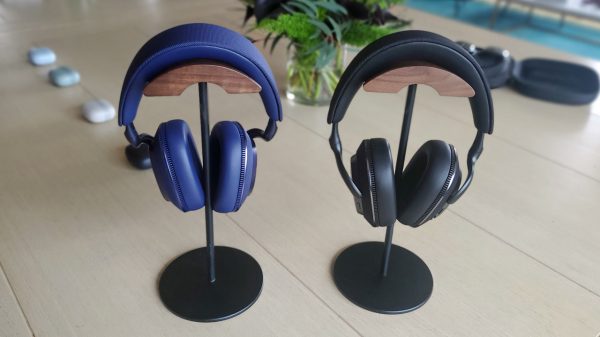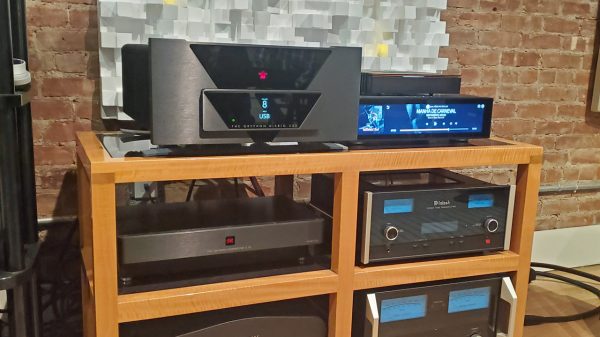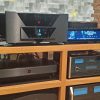As eCoustics Editor-in-Chief Ian White and I discussed on our latest podcast episode, movie theaters are still suffering from lack of attendance. They’ve never returned to their pre-pandemic highs and 2024 may actually have lower box office numbers than 2023. Now this doesn’t mean there’s any shortage of high quality entertainment out there, only that the enjoyment of this content is happening much more often in the home than it is in movie theaters.
And that’s why every movie and music lover needs to invest in two things: a good TV or home projection system and a good sound system. But you don’t necessarily need to spend massive amounts of money on either. You can bring home a nice 65-inch OLED TV for under $2,000 or even a huge 98-inch LED/LCD TV or a 120-inch UST or home theater projection system for under $3,000. And there are plenty of choices in component surround sound systems or high quality soundbars for well below $2,000. One such choice is LG’s S95TR Soundbar system (MSRP: $1,499 but available for less online).
What Is It?
Some inexpensive soundbars bill themselves as “Dolby Atmos” soundbars without rear speakers. These products use a process called virtualization to simulate surround via electronic processing and psychoacoustics principles. But in our experience, these types of bars do not provide a very convincing illusion of immersion. The LG S95TR uses discrete speakers for surround and height channels, so it is capable of truly immersive surround sound.
I refer to the S95TR as a “soundbar system” because, unlike many of its competitors, LG actually includes everything you need for an immersive surround sound experience in the box: the soundbar itself, a wireless subwoofer and wireless rear surround speakers. Sony’s current BRAVIA BAR 8 and BRAVIA BAR 9 require separate purchase of a sub and surround speakers and even their top of the line BRAVIA Theatre Quad system requires the subwoofer to be purchased separately. As long as you’ve got power outlets in the front and back of your room, you’ll get everything you need in the box with the S95TR, even the HDMI cable.

Drivers Firing Everywhere
Soundbar systems which promise discrete immersive surround typically use multiple speaker drivers in the soundbar itself and in the rear speakers to fire sound in different directions using the wall and ceiling to reflect sound back to the listener. The LG S95TR is no exception. The LG S95TR soundbar features not two but three up-firing drivers to bounce sound off the ceiling for height effects as well as side-firing drivers to bounce sound off the wall for surround effects. The included rear speakers actually fire sound in three different directions – to the left and to the right for surround effects (bouncing sound off both the side and rear walls) as well as additional top-firing speakers bouncing sound off the ceiling for height effects. The end result is a system which LG describes as “9.1.5-channels” – nine surround channels at ear level, one powered subwoofer and five discrete height channels. In our testing, this is a bit of an exaggeration, but we’ll get to that later.

Although there are some who say reflective speaker drivers have no business in home theater systems, I beg to differ. In specific room layouts: rooms which are not too tall, too long or too wide, with walls and ceiling at right angles, reflective drivers can create a convincing three-dimensional immersive soundstage. Reflective speakers don’t work as well in irregularly shaped rooms, rooms with ceilings over 12 feet high or in rooms with absorptive ceilings or walls. But for those who don’t have the option of cutting holes in walls or ceilings, or those who want a simpler solution, up-firing and side-firing drivers can work pretty well to create an immersive soundstage.
But don’t take my word for it; upward-firing drivers are even allowed in the CEDIA/CTA-RP22 Immersive Audio Design recommended practices for level 1 and level 2 home theater certification. If you want to meet the more strict level 3 and level 4 certifications, you’ll need discrete direct-firing height and surround speakers. You’ll also need to spend a whole lot more than $1500. But I digress…
The benefit of having all these speakers pointing in different directions is that the LG S95TR system can create a more realistic and three dimensional soundstage, particularly on movies, music and TV shows with Dolby Atmos or DTS:X encoding.
The Set-Up
Setting up the S95TR system is pretty straightforward. The soundbar can be wall-mounted or placed in front of the TV on a credenza or stand. The bar itself is only 2.5″ high so it probably won’t block your TV’s IR remote sensor if you put the bar below your TV. The surround speakers should be placed behind the listener (if possible). If your couch is right up against the rear wall, then you can place the rear speakers on the wall on both sides of your couch angled so that the inner facing surround speakers reflect sound off the rear wall. This will allow rear channel sound to come from behind you. You may have to experiment with subwoofer placement a bit to get the best bass response in your “sweet spot” but start with it in the front of the room on either side of the TV around a foot from the wall and adjust placement if necessary.
The soundbar, subwoofer and each surround speaker do require power, so make sure you’ve got a plug nearby each one or an extension cord to bring power to each speaker. Once everything is plugged in, you’ll need the LG Soundbar app, which is available on the Google Play Store or Apple’s app store. Connect your phone to your home wireless network and follow the prompts in the soundbar app to find and set-up your system components. The app should be able to find and connect all of the system components as long as they’re all plugged in to AC power.
The next step is to plug the included HDMI cable into the input on the back of the bar labeled “ARC/eARC” and connect that to the similarly labeled eARC or ARC HDMI port on your television or projector. If you have an older TV which lacks ARC or eARC HDMI ports, then you can use an optical digital cable to connect the bar to the TV but with this type of connection, you’ll be limited to PCM stereo, Dolby Digital 5.1 or DTS 5.1 surround sound. You won’t be able to take advantage of Dolby Atmos or DTS:X immersive soundtracks unless you plug a separate streaming stick, gaming console or Blu-ray Disc player directly into the soundbar’s second HDMI input.

You can skip the wired connection entirely if you match the LG soundbar up with a recent LG TV with its wireless Wow Orchestra features. This also allows you to use the TV’s built-in speakers concurrently with the soundbar, for possibly even more enveloping sound. We tested the S95TR with a TCL MiniLED TV so were not able to test the LG TV-specific features.
Once everything is properly connected and the speakers are in their final locations, select the “AI Room Calibration” feature in the app to optimize the speaker levels for your specific room. Once you’ve done this, watch some movie or TV show clips and listen to some music. If you feel like the levels need to be adjusted manually, you can do this in the LG Soundbar app. And if the bass is bloated or weak in your favorite listening spot, try moving the subwoofer a bit to the left or right until the bass sounds solid, but not overly boomy.
You can also experiment with the different listening modes or “Sound Effects” in the LG Soundbar app and pick the sound mode that sounds best to your ears. For me, that was mostly “Standard” or “Cinema.” Standard is the most neutral sounding mode while Cinema mode makes the bass a bit more prominent, brings midrange frequencies like dialog and vocals forward and makes the dynamics a bit more punchy overall. The “AI Sound Pro” mode accentuates spatiality but actually makes the overall sound less cohesive. Not a fan. The bar does include a “Night Mode” which compresses the dynamic range a bit so it doesn’t get too loud. There’s also a “Clear Voice Pro” effect which enhances dialog in case you’re having trouble making out what actors are saying.
Connectivity and Features Up the Wazoo
The LG S95TR has plenty of inputs including HDMI/eARC, a second HDMI input, a fiberoptic digital input, Bluetooth and USB. The HDMI/ARC/eARC connection will get sound from your TV’s tuner, streaming apps and any source components connected directly to the TV. The second HDMI port is handy for connecting a disc player, gaming console or streaming stick, in case your TV’s built-in apps don’t support Dolby Atmos or DTS:X surround or your TV can’t pass these formats through its HDMI port.

The included remote control gives you access to all the essentials including input switching, volume, mute and sound effect selection. There is no real display on soundbar itself, except a few LED lights to show the basics like mute and volume level. So when you cycle through inputs or sound effect modes using the remote control, a built-in voice in the bar lets you know which mode or input you’ve selected.
The S95TR supports Apple AirPlay 2, Spotify Connect, Google Chromecast and TIDAL Connect. Unlike other soundbars and packaged home theater systems we’ve tested, (including the Sony BRAVIA Theatre QUAD speaker system), the LG S95TR supports Dolby Atmos over TIDAL Connect. This means you can use the TIDAL app on your phone to play songs and playlists mixed in Dolby Atmos immersive surround over all the speakers in the S95TR system. Most soundbars and systems that support TIDAL Connect only support 2-channel stereo audio streams. Meanwhile using Google Chromecast, the Amazon Music app on my phone would not pass Dolby Atmos tracks to the soundbar, while they would pass Dolby Atmos tracks to the TCL TV. So this does appear to be a limitation in the LG’s Google Cast implementation on the S95TR.
The S95TR system can decode Dolby Atmos and DTS:X immersive surround. It even supports the lossless Dolby TrueHD and DTS:HD Master Audio codecs as well as high resolution stereo audio up to 24-bit/192KHz. To fully support immersive surround, the system includes no less than 17 separate speaker drivers, powered by 820 watts of total system amplification.
We’re Listening
Over the course of the review, I connected the S95TR soundbar system to a TCL QM851G MiniLED TV via HDMI/eARC, using that TV’s GoogleTV streaming apps for much of my viewing and listening. I also connected a Roku 4K+ streaming stick as well as a FireTV 4K stick for streaming apps that did not support Dolby Atmos on the TV itself. I also connected a Sony UHD Blu-ray Player directly to the soundbar’s HDMI port so I could test lossless immersive surround sound (Dolby Atmos over Dolby TrueHD and DTS:X over DTS-HD Master Audio). For music, I used TIDAL and Amazon Music Unlimited in order to get high resolution stereo music as well as spatial audio music tracks encoded in Dolby Atmos.

To confirm the set-up and see how the system reproduced immersive surround, I used DTS:X and Dolby Atmos channel tests on the Spears and Munsil UHD benchmark (Disc 3) as well as Dolby and DTS test discs. The results were a bit unexpected. With so many speaker drivers pointing in so many directions, I assumed the S95TR system would create a fully seamless and immersive soundstage all around and above the listening position. But the system does not really take full advantage of all of the speakers at its disposal.
Let me step back a bit to explain. The S95TR soundbar is billed as a “9.1.5-channel system.” It includes front-firing drivers for left, center and right channels. It includes up-firing drivers for height effects, bouncing sound from the ceiling so it comes from above the listener. The soundbar also includes side-firing drivers to bounce sound off the walls to recreate sounds coming from the sides of the listening area. The S95TR’s rear surround speakers also include drivers that point toward the side wall, as well as rear-facing drivers for sound behind you and up-firing drivers for height effects.

But when I played DTS:X and Dolby Atmos channel tests in a 7.1.4 or 9.1.6 channel configuration, the S95TR system only fired the side-firing drivers on the surround speakers when it was fed a rear surround channel signal. When cycling through the seven (or nine) surround channels, only the soundbar’s built-in side-firing speakers are used to recreate the side surround channels. Also, the “wide front” channels of a 9-channel surround sound signal are indistinguishable from the regular front left/right channels. The net effect is that the system can’t accurately reproduce a 9-channel soundfield (with front wide channels) and the tracking from front to back of a seven channel surround signal isn’t quite as seamless from front to back as it could be.
I had expected the side surround signal to be reproduced by both the soundbar’s side-firing drivers and the rear speaker’s side-firing drivers, creating a phantom side surround channel at the midpoint of the side walls. But this was not the case. And this led to a slight gap in the immersive effect along the sides. Meanwhile, the five height speakers did create a seamless height effect from front to rear.
I asked LG’s Senior Product Marketing Manger, Jack Kiledjian about this and he confirmed that it works this way by design. “As you noted, the side surround channels only use the S95TR soundbar’s side-firing drivers. This is in line with the 7.1.4 channel Dolby Atmos speaker configuration for soundbars, where the side surround channel sound should only output from the side speakers of the soundbar unit. These are designed to reflect off the left and right walls of the room to reach the listener.”
He went on to describe the function of the rear side-firing drivers on the rear speakers: “The rear surround (or rear side) speakers are not intended for actual spatial encoding purposes. Instead, they’re designed to compensate for sound shadows caused by installation constraints such as room layout, furniture placement, and other factors.”
So the rear speakers have drivers facing in two directions in order to compensate for less than ideal speaker placements or room layouts and still bring a strong feeling of immersion throughout the listening room. Is it really a 9.1.5-channel system? Not exactly. But it does conform to Dolby’s guidelines for a 7.1.4-channel soundbar system so we can safely call it that. And the inclusion of both rear and side firing drivers on the rear speakers does fill in the sound in the rear part of the listening room.
Let The Music Play
Diving into music listening, I relied mostly on streaming services Amazon Music Unlimited and TIDAL, both of which support high resolution audio and Dolby Atmos spatial audio for music. On TIDAL, I used the phone app, connected to the bar via TIDAL Connect. For Amazon Music Unlimited, I used a FireTV Stick 4K as the TV’s built-in Amazon Music app didn’t support Dolby Atmos.
I like listening to EDM like the Deadmau5/KX5 collaboration album to test spatiality, dynamics and bass reponse. Their Dolby Atmos track “Alive” on TIDAL will give any system a workout. On the LG system, the track was punchy and enveloping, with solid bass. The bass didn’t reach quite as low as on component systems or even as the Sony Quad system (with the larger optional sub) but it hit a solid 40 Hz which provided plenty of oomph. About 4 minutes into the song, a percussion track rotates 360 degrees around the room and there were some minor differences in speaker timbre that kept this from being entirely seamless. There was also that side surround gap which detracted slightly from the cohesiveness of the mix. But for the most part, the S95TR system did an excellent job creating an immersive and enveloping soundstage for this track.

The 2023 remaster of Pink Floyd’s “Dark Side of the Moon” in Dolby Atmos on Amazon Music Unlimited also sounded particularly full and immersive on the LG system, making me feel like I was inside the mix with instruments and voices enveloping me from all sides. It’s fun being able to go back to this 50-year old recording and hear it in a completely new way.

Ed Sheeran’s “Shape of You” is another track that was recently remastered in Dolby Atmos and the spatial details and dynamic build-up of the song were well captured by the LG system. On the mellower side, the Dolby Atmos mixes of “30th” by Billy Ailish and “All of the Girls You’ve Loved Before” by Taylor Swift provided a nice sense of intimacy and excellent vocal articulation, with instruments and effects helping draw the listener in from all directions.
Overall, I felt like this LG system was a bit more expansive and cohesive for music listening than the Sony Theatre Quad system but the timbre and overall tonal accuracy wasn’t quite as impressive as the much more expensive Sony system (which sells for twice the price).
On With the Show
Moving on to movies and TV shows, I put on the first episode of “Andor” from Disney+ and confirmed that theS95TR system was able to realistically reprocuce the rain falling from above. Moving into the night club, the system did a pretty good job of keeping the dialog clear with dance music in the background. I did notice a little thumpiness to the bass in this scene when in “Cinema” effect mode.

On Denis Villeneuve’s “Dune,” when the giant sandworm attacks the spice mining crawler, the system did a good job of maintaining its composure while sand swirled, music swelled and ghostly voices of the Bene Gesserit echoed in Paul Atreides’ head. On “Mad Max: Furiosa” the system presented the bombastic sound mix with solid dynamics, good spatiality and solid bass heft.
On UHD Blu-ray Disc, the “Blade Runner” Final Cut 4K remaster in Dolby Atmos sounded great on the S95TR. Vangelis’ ethereal soundtrack blended well with the dialog and spatial effects creating a fully immersive soundstage with excellent spatiality. Leon’s knock just before his interview with Holden near the beginning of the film made me turn to see if someone was at the door.
Moving on to DTS:X, I selected “Ex Machina” – the first Blu-ray Disc to include a DTS:X soundtrack. Right from the opening scene with a helicopter landing and dropping off the hapless Caleb Smith into a secluded rain forest, the audience is drawn into the film’s reality via the immersive soundtrack. The S95TR had no problems decoding the DTS:X track on this disc.
Pulling out some older content, I popped in “Moulin Rouge” on DVD with its DTS Digital soundtrack. This DVD still sounded great, 30 years after it came out, with articulate vocals in the many musical numbers, nice dynamics and decent low end response. The S95TR had no trouble keeping up here. I did notice on this and some other discs that there was a lip synch error between the audio and video. Fortunately the S95TR has an “AV Sync” setting in “Audio Settings” which allows you to delay the audio up to 300 ms. I found setting the delay to 190 ms solved the problem on the few occasions when this occured.
Overall the sound of the S95TR system was enjoyable, particularly considering its simplicity: no speaker wires or separate receiver to worry about. There was a slight bloat to the mid-bass that was hard to tame. It was only noticeable during certain content. Stepping the subwoofer output down one or two ticks in the app can ameliorate this thump, but then the bass gets a bit thin. Also, the system can get a bit congested at high volumes, but that is pretty common on soundbar systems.
Pros:
- Can create truly immersive surround sound in the right room thanks to 17 different speaker drivers
- Flexible connectivity options, including second HDMI port
- Supports real Dolby Atmos, DTS:X and 24/96KHz High Res Audio
- TIDAL Connect supports Dolby Atmos music
- Everything Included: soundbar, subwoofer, rear speakers and HDMI cable
Cons:
- Requires walls that aren’t too far and ceiling that isn’t too high for best effect (common issue with soundbars and reflective drivers)
- Bass doesn’t extend much below 40 Hz
- Some tubbiness to the mid bass
- Treble articulation and timbre slightly lacking, compared to component speaker systems
- A bit pricey at MSRP (wait for a sale)
The Bottom Line
The LG S95TR offers a huge improvement in TV sound and can capture immersive surround formats including Dolby Atmos and DTS:X well in the right room. If your ceilings are too high or are textured or irregular, or if your side walls are too far away then you won’t get the best results, but this is a common issue for any speaker system which relies on side-facing or up-facing drivers. By including so many side facing and upward-facing drivers in the system, the LG S95TR gives you a much better chance of getting immersive sound in your room compared to a more basic 5.1 or 5.1.2-channel soundbar system.
At $1499, the S95TR is a bit pricey, but if you can get it bundled with an LG TV or at a decent discount, then we can heartily recommend it for a taste of that immersive home theater surround sound with everything you need right in the box.
Where to Buy: $1,499 $1,285 at Amazon
Related Reading: Sony BRAVIA Theatre Quad Speaker System Review







